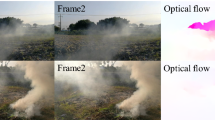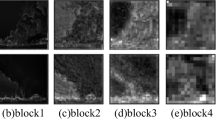Abstract
This paper proposes a smoke semantic segmentation framework EANet based on boundary enhancement and attention mechanism. It integrates semantic segmentation and semantic boundary detection tasks into a framework, and distinguishes the features on both sides of the boundary with the help of the supervision of the semantic boundary, so as to guide the semantic segmentation task to determine whether the features on both sides of the boundary belong to the same object. At the same time, three attention mechanisms are proposed, which are used to capture the long-range context-dependent information of the object, strengthen the boundary semantic information of the segmentation feature, and enhance the attention to the key features of the channel domain. Finally, an adaptive fusion layer is used to fuse the prediction results of the two sub-networks to further improve the details of the segmentation results and obtain sharper object boundaries. In addition, in order to solve the problem of sample imbalance in the semantic boundary detection task, we designed a boundary loss function EL. By improving the standard binary cross-entropy, the network can focus more on difficult-to-classify samples and improve the network’s ability to deal with sample imbalance problems. A large number of experimental results show that our method is better than the state-of-art algorithms, and the proposed loss function can also help the algorithm to obtain more accurate and clear object boundaries.















Similar content being viewed by others
Data availability
The data that support the findings of this study are available on request from the corresponding author LZ. The data are not publicly available because they contain information that could compromise research participant privacy/consent.
References
Chen L, Zhang H, Xiao J, et al. (2017) SCA-CNN: spatial and channel-wise attention in convolutional networks for image captioning. Computer Vision and Pattern Recognition, 6298–6306
Chen L, Papandreou G, Kokkinos I, et al. (2015) Semantic image segmentation with deep convolutional nets and fully connected CRFs. International Conference on Learning Representations
Chen B, Gong C, Yang J (2019) Importance-aware semantic segmentation for autonomous vehicles. IEEE Trans Intell Trans Syst 20(1):137–148
Chen J, Liu Z, Jin D, Wang Y, Yang F, Bai X (2022) Light transport induced domain adaptation for semantic segmentation in thermal infrared urban scenes. IEEE Trans Intell Transp Syst 23:23194–23211. https://doi.org/10.1109/TITS.2022.3194931
Dimitropoulos K, Barmpoutis P, Grammalidis N et al (2017) Higher order linear dynamical systems for smoke detection in video surveillance applications. IEEE Trans Circ Syst Video Technol 27(5):1143–1154
Filonenko A, Hernández DC, Jo K (2018) Fast smoke detection for video surveillance using CUDA. IEEE Trans Industr Inform 14(2):725–733
Fu J, Liu J, Tian H et al (2019) Dual attention network for scene segmentation. IEEE Conference on Computer Vision and. Pattern Recogn:3146–3154
Gu J, Hu H, Wang L et al (2018) Learning region features for object detection. European Conference on Computer Vision:392–406
Hu J, Shen L, Gan S (2018) Squeeze-and-excitation networks[C]. IEEE conference on computer vision and Pattern Recogn, 7132–7141
Hu J, Shen L, Albanie S, et al. (2018) Gather-Excite: exploiting feature context in convolutional neural networks. neural information processing systems, 9401–9411
Hu H, Gu J, Zhang Z et al (2018) Relation networks for object detection[C] IEEE conference on computer vision and. Pattern Recogn:3588–3597
Hu X, Yang K, Fei L, et al. (2019) ACNet: attention based network to exploit complementary features for RGBD semantic segmentation, ICIP
Huang G, Liu Z, Der Maaten LV et al (2017) Densely connected convolutional networks. IEEE Conference on Computer Vision and Pattern Recognition:2261–2269
Huang Z, Wang X, Huang L et al (2018) CCNet: Criss-cross attention for semantic segmentation. International Conference on Computer Vision:603–612
Islam MA, Naha S, Rochan M et al (2017) Label refinement network for coarse-to-fine semantic segmentation. arXiv: computer vision and. Pattern Recognition
Kaabi R, Sayadi M, Bouchouicha M, et al. (2018) Early smoke detection of forest wildfire video using deep belief network. International Conference on Advanced Technologies for Signal and Image Processing, 1–6
Li X, Chen Z, Wu QM et al (2020) 3D parallel fully convolutional networks for real-time video wildfire smoke detection. IEEE Trans Circ Syst Video Technol 30(1):89–103
Lin TY, Goyal P, Girshick R et al (2017) Focal loss for dense object detection[J]. IEEE Trans Pattern Anal Machine Intell 99:2999–3007
Lin G, Milan A, Shen C et al (2017) RefineNet: multi-path refinement networks for high-resolution semantic segmentation. IEEE Conference on Computer Vision and Pattern Recognition:5168–5177
Lin Z, Liu HH, Wotton M et al (2019) Kalman filter-based large-scale wildfire monitoring with a system of UAVs. IEEE Trans Ind Electron 66(1):606–615
Liu H., Zhang J., Yang K. et al. (2022) CMX: Cross-modal fusion for RGB-X semantic segmentation with transformers. arXiv:2203.04838
Luo Y, Zhao L, Liu P, Huang D (2018) Fire smoke detection algorithm based on motion characteristic and convolutional neural networks. Multimed Tools Appl 77(12):15075–15092
Mahmoud MAI, Ren H (2019) Forest fire detection and identification using image processing and SVM. J Inform Process Syst 15(1):159–168
Newell A, Yang K, Deng J et al (2016) Stacked hourglass networks for human pose estimation. European Conference on Computer Vision:483–499
Peng C, Zhang X, Yu G et al (2017) Large kernel matters — improve semantic segmentation by global convolutional network. IEEE Conference on Computer Vision and Pattern Recognition:1743–1751
Sagar AG, Nath S, Nagrath P (2018) Smoke detection in digital frames. Int Res J Eng Technol 5(4):3843–3846
Strudel R, Garcia R, Laptev I et al (2021) Segmenter: transformer for semantic segmentation. International Conference on Computer Vision:7262–7272
Takikawa T, Acuna D, Jampani V, et al. (2019) Gated-SCNN: Gated Shape CNNs for Semantic Segmantation. International Conference on Computer Vision: 5229–5238
Tian H, Li W, Ogunbona PO, Wang L (2018) Detection and separation of smoke from single image frames. IEEE Trans Image Process 27(3):1164–1177
Vaswani A, Shazeer N, Parmar N et al (2017) Attention is all you need. Neural Inform Process Syst:6000–6010
Wang X, Girshick R, Gupta A, et al. (2018) Non-local neural networks. Computer Vision and Pattern Recognition, : 7794–7803
Wang W, Shen J, Shao L et al (2018) Video salient object detection via fully convolutional networks[J]. IEEE Trans Image Process 27(1):38–49
Woo S, Park J, Lee J et al (2018) CBAM: convolutional block attention module[C]. European Conference on Computer Vision:3–19
Xie S, Tu Z (2015) Holistically-nested edge detection. International Conference on Computer Vision:1395–1403
Xie E, Wang W, Yu Z, et al. (2021) SegFormer: simple and efficient design for semantic segmentation with transformers. NeurIPS
Yang J, Lin G, Wang J, Fang J, Zhang Y (2016) Early video smoke segmentation algorithm based on saliency detection and Gaussian mixture model. Comput Eng 42(2):206–209
Yang J, Price B, Cohen S, et al. (2016) Object contour detection with a fully convolutional encoder-decoder network. Computer Vision and Pattern Recognition, 193–202
Yang M, Yu K, Zhang C et al (2018) DenseASPP for semantic segmentation in street scenes. IEEE Conference on Computer Vision and Pattern Recognition:3684–3692
Ye L, Rochan M, Liu Z et al (2019) Cross-modal self-attention network for referring image segmentation. IEEE Conference on Computer Vision and Pattern Recognition:10502–10511
Yu Z, Feng C, Liu M, et al. (2017) CASENet: deep category-aware semantic edge detection. Computer vision and pattern recognition: 1761-1770
Yu C, Wang J, Peng C et al (2018) Learning a discriminative feature network for semantic segmentation[C]. IEEE Conference on Computer Vision and Pattern Recognition:1857–1866
Yuan F, Zhang L, Xia X, Wan B, Huang Q, Li X (2019) Deep smoke segmentation. Neurocomputing 357:248–260
Yuan C, Liu Z, Zhang Y et al (2019) Learning-based smoke detection for unmanned aerial vehicles applied to Forest fire surveillance. J Intell Robot Syst 93:337–349
Yuan F, Zhang L, Xia X, Huang Q, Li X (2020) A wave-shaped deep neural network for smoke density estimation. IEEE Trans Image Process 29:2301–2313
Yuan F, Zhang L, Xia X, Huang Q, Li X (2021) A gated recurrent network with dual classification assistance for smoke semantic segmentation. IEEE Trans Image Process 30:4409–4422
Yuan Y, Huang L, Guo J et al (2021) OCNet: object context for semantic segmentation. Int J Comput Vis:1–24
Zhang N, Wang H, Yan H (2015) Smoke image segmentation algorithm based on rough set and region growing. J Front Comput Sci Technol 11(8):1296–1299
Zhang Z, Zhang C, Shen W et al (2016) Multi-oriented text detection with fully convolutional networks. IEEE Conference on Computer Vision and Pattern Recognition:4159–4167
Zhang H, Dana KJ, Shi J et al (2018) Context encoding for semantic segmentation. IEEE Conference on Computer Vision and Pattern Recognition:7151–7160
Zhao Y (2015) Candidate smoke region segmentation of fire video based on rough set theory. J Electric Comput Eng 11
Liu Y, Cheng M, Hu X et al (2017) Richer convolutional features for edge detection Computer vision and pattern recognition 41(8):1939–1946
Zhao H, Shi J, Qi X et al (2017) Pyramid scene parsing network. IEEE Conference on Computer Vision and Pattern Recognition:6230–6239
Zhao H, Zhang Y, Liu S et al (2018) PSANet: point-wise spatial attention network for scene parsing. European Conference on Computer Vision:270–286
Zhen M, Wang J, Zhou L, et al. Learning fully dense neural networks for image semantic segmentation[C]. AAAI2019.
Zheng S, Lu J, Zhao H et al (2021) Rethinking semantic segmentation from a sequence-to-sequence perspective with transformers. IEEE Conference on Computer Vision and Pattern Recognition:6881–6890
Funding
This work was supported by [The National Natural Science Foundation of China (No. 62262027 and No. 62162029), Ph.D. Research Startup Fund (No. 2020BSQD013), Jiangxi Provincial Natural Science Foundation (No. 20212BAB202012) and the Key Science Technology Application Projects of Jiangxi Province (GJJ2201311)].
Author information
Authors and Affiliations
Corresponding author
Additional information
Publisher’s note
Springer Nature remains neutral with regard to jurisdictional claims in published maps and institutional affiliations.
Rights and permissions
Springer Nature or its licensor (e.g. a society or other partner) holds exclusive rights to this article under a publishing agreement with the author(s) or other rightsholder(s); author self-archiving of the accepted manuscript version of this article is solely governed by the terms of such publishing agreement and applicable law.
About this article
Cite this article
Zhang, L., Yuan, F. & Xia, X. Edge-reinforced attention network for smoke semantic segmentation. Multimed Tools Appl 82, 31259–31284 (2023). https://doi.org/10.1007/s11042-023-14879-z
Received:
Revised:
Accepted:
Published:
Issue Date:
DOI: https://doi.org/10.1007/s11042-023-14879-z




